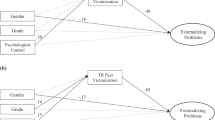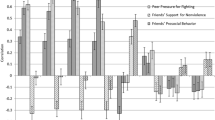Abstract
Parent, teacher, and peer ratings were collected for 75 grade school boys to test the hypothesis that certain family interaction patterns would be associated with poor peer relations. Path analyses provided support for a mediational model, in which punitive and ineffective discipline was related to child conduct problems in home and school settings which, in turn, predicted poor peer relations. Further analyses suggested that distinct subgroups of boys could be identified who exhibited conduct problems at home only, at school only, in both settings, or in neither setting. Boys who exhibited cross-situational conduct problems were more likely to experience multiple concurrent problems (e.g., in both home and school settings) and were more likely than any other group to experience poor peer relations. However, only about onethird of the boys with poor peer relations in this sample exhibited problem profiles consistent with the proposed model (e.g., experienced high rates of punitive/ineffective home discipline and exhibited conduct problems in home and school settings), suggesting that the proposed model reflects one common (but not exclusive) pathway to poor peer relations.
Similar content being viewed by others
References
Becker, W. C., Peterson, D. R., Hellmer, L. A., Shoemaker, D. J., & Quay, H. C. (1959). Factors in parental behavior and personality as related to problem behaviors in children.Journal of Consulting Psychology, 23, 107–118.
Bierman, K. L. (1986). The relationship between social aggression and peer rejection in middle childhood. In R. Prinz (Ed.), Advances in behavioral assessment of children and families, Vol. 2, (pp. 151–178). Greenwich, CT: JAI Press.
Buss, A. H. (1961). The psychology of aggression. New York: Wiley and Sons.
Buss, A. H., & Durkee, A. (1957). An inventory for assessing different kinds of hostility.Journal of Consulting Psychology, 21, 343–348.
Coie, J., Dodge, K., & Coppotelli, H. (1982). Dimensions and types of social status: A crossage perspective.Developmental Psychology, 18, 557–570.
Coie, J. D., Dodge, K. A., & Kupersmidt, J. (1990). Peer group behavior and social status. In S. R. Asher & J. D. Coie (Eds.), Peer rejection in childhood (pp. 17–59). New York: Cambridge University Press.
Conners, C. (1969). A teacher rating scale for use in drug studies with children.American Journal of Psychiatry, 126, 152–156.
Emery, R. E. (1982). Interparental conflict and the children of discord and divorce.Psychological Bulletin, 92, 310–330.
Emery, R. E., & O'Leary, K. D. (1984). Marital discord and child behavior problems in a nonclinic sample.Journal of Abnormal Child Psychology, 12, 411–420.
Forehand, R., Long, N., Brody, G. H., & Fauber, R. (1986). Home predictors of young adolescents' school behavior and academic performance.Child Development, 51, 1528–1533.
French, D. C. (1988). Heterogeneity of peer-rejected boys: Aggressive and non-aggressive subtypes.Child Development, 59, 976–985.
Gottman, J. (1979). Marital interaction: Experimental investigations. New York: Academic Press.
Knoll, P. D. (1970). A further methodological study of the measurement of interpersonal aggression.Psychological Reports, 26, 807–809.
Locke, H. J., & Wallace, K. M. (1959). Short marital-adjustment and prediction tests: Their reliability and validity.Marriage and Family Living, August, 251–255.
Loeber, R. (1982). The stability of antisocial and delinquent child behavior: A review.Child Development, 53, 1431–1446.
Loeber, R., & Dishion, T. J. (1984). Boys who fight at home and school. Family characteristics influencing cross-setting consistency.Journal of Consulting and Clinical Psychology, 52, 759–768.
Love, L. R., & Kaswan, J. W. (1974).Troubled children: Their families, schools and treatments. New York: Wiley and Sons.
MacDonald, K., & Parke, R. D. (1984). Bridging the gap: Parent-child play interaction and peer interactive competence.Child Development, 55, 1265–1277.
McCord, W., McCord, J., & Zola, I. K. (1959).Origins of crime. New York: Columbia University Press.
Montemayor, R. (1982). The relationship between parent-adolescent conflict and the amount of time adolescents spend alone and with parents and peers.Child Development, 53, 1512–1519.
Oltmanns, T. F., Broderick, J. E., & O'Leary, K. D. (1977). Marital adjustment and the efficacy of behavior therapy with children.Journal of Consulting and Clinical Psychology, 45, 724–729.
Oweus, D. (1980). Familial and temperamental determinants of aggressive behavior in adolescents: A causal analysis.Developmental Psychology, 16, 644–660.
Parke, R. D., MacDonald, K. B., Burks, J. M., Carson, J., Bharnagri, N., Barth, J., & Beital, A. (1989). Family and peer systems: In search of linkages. In K. Kreppner & R. H. Lerner (Eds.),Family systems and life-span development (pp. 65–92). Hillsdale, NJ: Erlbaum.
Parke, R. D., & Slaby, R. G. (1983). The development of aggression. In E. M. Hetherington (Ed.), P. A. Mussen (Series Ed.),Handbook of child psychology: Vol. 4. Socialization, personality, and social development (pp. 547–642). New York: Wiley.
Parker, J. G., & Asher, S. R. (1987). Peer relations and later personal adjustment: Are lowaccepted children at risk?Psychological Bulletin, 102, 357–389.
Patterson, G. R. (1986). Performance models for antisocial boys.American Psychologist, 41, 432–444.
Patterson, G. R., Dishion, T. J., & Bank, L. (1984). Family interaction: A process model of deviancy training.Aggressive Behavior, 10, 253–267.
Patterson, C. R., Littman, R. A., & Bricker, W. (1967). Assertive behavior in children.Monographs of the Society for Research in Child Development, 32, 1–43.
Patterson, G. R., & Stouthamer-Loeber, M. (1984). The correlation of family management practices and delinquency.Child Development, 55, 1299–1307.
Pekarik, E. G., Prinz, R. J., Liebert, D. E., Weintraub, S., & Neale, J. M. (1976). The Pupil Evaluation Inventory. A sociometric technique for assessing children's social behavior.Journal of Abnormal Child Psychology, 4, 83–97.
Pettit, G. S., Dodge, K. A. & Brown, M. M. (1988). Early family experience, social problem solving patterns and children's social competence.Child Development, 59, 107–120.
Putallaz, M. (1987). Maternal behavior and children's sociometric status.Child Development, 58, 324–340.
Putallaz, M., & Heflin, A. H. (1990). Parent-child interaction. In S. R. Asher and J. D. Coie (Eds.),Peer rejection in childhood (pp. 189–216). New York: Cambridge University Press.
Quay, H. C., & Peterson, D. R. (1975).Manual for the Behavior Problem Checklist. Unpublished manuscript.
Schacher, R., Rutter, M., & Smith, H. (1981). The characteristics of situationally and pervasively hyperactive children: Implications for syndrome definition.Journal of Child Psychology and Psychiatry, 22, 375–392.
Touliatos, J., & Lindholm, B. W. (1981). Relationships of children's grade in school, sex and social class to teacher ratings on the Quay-Peterson Behavior Problem Checklist.Journal of Abnormal Child Psychology, 9, 23–46.
Wahler, R. C. (1975). Some structural aspects of deviant child behavior.Journal of Applied Behavior Analysis, 8, 21–42.
Author information
Authors and Affiliations
Additional information
This research was supported in part by a Scholars in Mental Health of Children grant awarded by the W. T. Grant Foundation to the first author.
We are indebted to Julian F. Thayer for his statistical consultation and insightful comments and to Timothy G. Swensen for his helpful suggestions on an earlier draft of this manuscript.
Appreciation is also expressed to Rossana D'Alessio, Chris Doran, Julie Hood, Paul Lamon, and Kathryn McPherson for their assistance in data collection and sorting. Finally, we are extremely grateful to the participating boys and their parents and to the faculty and staff at Corl Street, Easterly Parkway, and Park Forest Elementary Schools in State College, Pennsylvania, and Bellefonte Elementary School in Bellefonte, Pennsylvania, for their help with and support of this project.
Rights and permissions
About this article
Cite this article
Bierman, K.L., Smoot, D.L. Linking family characteristics with poor peer relations: The mediating role of conduct problems. J Abnorm Child Psychol 19, 341–356 (1991). https://doi.org/10.1007/BF00911236
Revised:
Issue Date:
DOI: https://doi.org/10.1007/BF00911236




